#aristaisan
Text
Aristasian books & Literature on Archive.org
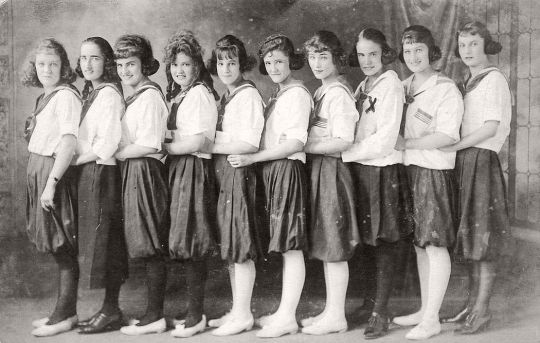
There is a wealth of information about Aristasia and proto-Aristasia available as books on archive.org! They easily pop up when you just search "Aristasia" but it may be a little bit confusing if you don't know what you're looking for, so hopefully this helps other pettes in their searches.
Artemis Magazine
Artemis #5
Artemis #6
Artemis was a wlw lesbian zine released in the mid 1980s by a group of women who were directly involved in the St. Bride's School onward. A number of them were released, but only volumes 5 & 6 are available on the internet currently. These are interesting because they frequently have articles written by known Aristasians, and you can really see the tiny little baby blossoms of Aristasia here, including articles about St. Bride's School.
Various Romantia Magazines
Realm of Romantia
Imperial Angel #1
Imperial Angel #2
The Romantic #1
The Romantic #2
The Romantic #3
The Romantic #4
The Romantic #5
There are a number of different Romantia zines released, I have skipped over The English Magazine in this list, simply because there isn't a ton of proto-Aristasian information in those, it's mostly just pit-crit and secession-from-the-modern-world type stuff. Warning on one of these for some just outright racist copy of antique advertisements, unfortunately I can never remember which one it is until I find it. However, these do have very strong early world building, including the formation of the districts and the idea of racinated thinking.
The Wildfire Club
Children of the Void
The Female Disciplinary Manual
The Rule of the Strap
When the Wind is Free
The Feminine Regime
Disciplined Ladies
The District Governess
The Corporal Punishment of Schoolgirls
House of Correction
Happy Tears
The Wildfire Club was their 1990's publishing imprint. These are largely erotica books, some of them are written by Miss Martindale (by several different names), others are story compilations, at least one is a reprint of a much older book. Children of the Void is the most iconic Aristasian book and has the most Aristasia worldbuilding in it, the rest are, let's be very honest here, mostly just kind of smut by volume.
10 notes
·
View notes
Text
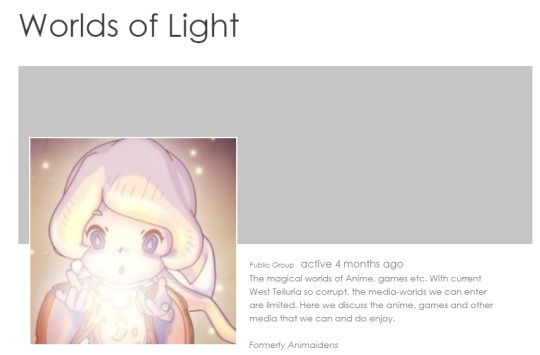
Chelouranya's Shining World forums certainly were a doozy! This was Aristasia at it's most elite, most inaccessible, and ironically, despite their embrace of modern Tellurian pop culture, their least appealing form to passing souls who may have otherwise been easily entangled in their racinated web.
Many of the old guard outer circle Aristasians were long gone by this point, as they had, quite literally, made weeabooism a religion. The emphasis was an unrelenting pleasantness.
This particular forum is from about 2014 - 2016.
5 notes
·
View notes
Text

The Mushrooms In America series was interesting for many reasons, particularly because it was some of the London Aristasians first adventure to visit some Culverian friends. Happening in 2005, they seemed to rent a convertible and travel along the coast for a road trip that ended in Disney World.
However, I chose to include this snippet because it includes a little description of a girl described by the mysterious “Hibiscus” of the Something Awful thread as “the heart of Aristasia”, and by the exiled Aristasian Miss Iris as Kim Jong-Il: Sushuri Madonna. She genuinely seemed to be the most seceded Aristasian, through snippets of her own personal stories, if you take them at face value, she didn’t seem to leave her embassy without the guardianship of another Aristasian, or even have a bank account of her own. She didn’t consider herself human, and seemed to be baffled by human life around her.
#Aristasian mushroom kingdom#aristaisan#aristasia#blondes and brunettes#aristasian#blonde and brunette#chelouranya
7 notes
·
View notes
Text
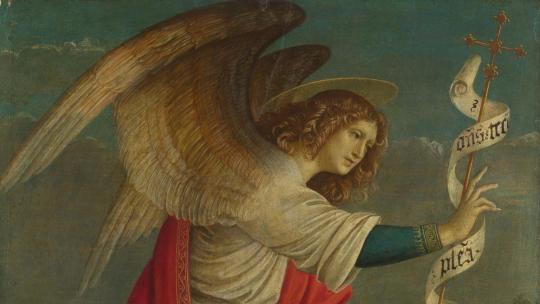
Sai Raya
Source
Sai Raya is the Sun: the Great Luminary. As such, she is the Janya most immediately assimilable to Dea Herself (although all the Janyati may be seen as Her Aspects). Her Aristasian name means simply The Lady, as well as The Radiant. Raya is the Aristasian word for Lady (in the Lord sense — there is no such specific word in English). Dea is sometimes addressed as Raya (Lady) even when the specific Aspect of Sai Raya, the Sun, is not intended. Her ancient Greek name is Theia, which is simply the feminine form of God, equivalent to Dea.
Very much might be said about the Sun. She is the Primordial Light, and it goes without saying that the physical luminary that represents Her in the material solar system is but an outward body or symbol of Her, just as the Sacred Mountain may be incarnated in some particular mountain on earth. The modern mind, with its shallow rationalism, finds it hard to grasp how very real is the incarnation of the Sacred Mountain in, say Mount Sinai, Mount Meru or Mount Olympus, how for their respective Traditions they are the one Sacred Mountain. But the Sun is a little simpler to understand, for there is only and can only be one Sun for the whole of terrestrial humanity.
And so materialism can fall into the opposite error — that of confusing the Supernal Sun with Her outward body (and so ludicrously imagining that traditional peoples worship "what we now know to be a ball of gas"). Sai Raya was before there was an earth to light or a Sun to light her. The same may be said of the Moon, and of each of the planets. They are Eternal Principles: principles that existed before our cosmos came into being and that will exist when all the worlds are dust.
As a principle governing terrestrial life, Sai Raya's influence (the word "influence" means, originally and literally, a "flowing-in" from the "stars", or celestial beings) is the most expansive and positive of all. Among the attributes of this influence are generosity, wealth, health, radiance and pride (pride in the negative sense is also the earthly perversion of the Stream of Sai Raya).
Solar associations are central to traditional symbolism the world over — the lion or the eagle figure in most Western national and imperial emblems. In the East the direct representation of the Sun is found in national emblems, such as that of Japan. The emperor of Japan is the direct descendant of the Sun Goddess, Amaterasu Omikami, just as the Empress of Aristasia is the direct descendant of Sai Raya.
Despite Western familiarity with the patriarchal classical world which sees the sun as masculine and the moon as feminine, this is rather an unusual perspective worldwide. The Sanskrit tradition masculinises both luminaries, while throughout the world the original Feminine Sun is to be found in a very large number of patriarchal cultures, sometimes with a masculine moon.
Japan has already been mentioned. Old Lithuanian songs have a feminine Sun-Deity, which is interesting because Lithuanian is the only still-living Indo-European language as ancient as Sanskrit, with which it shares many features. Its Solar Deity probably represents the pre-masculinised form of the Sun of the Sanskrit tradition. In the Celtic world the Sun Goddess is Grainne or Igraine; in Old Slavonic, Saule; among the ancient Semites, Athtar and various other names. In Germany, popular tradition still refers to Frau Sonne. The very word "Sun" comes from the name of the Scandinavian Sun-Goddess Sunna or Sunnu. Sunday, of course, is Her day. Just as Friday is a contraction of Freya's day, Sunday is a contraction of Sunna's Day.
The Sun, as symbolic centre of the macrocosm, is equivalent to the heart in the microcosm of the human body and the hearth-fire in the microcosm of the house. Thus it is that Intelligence is situated in the heart (governed by Sai Raya) and reason in the head (governed by Sai Candre). Needless to say, we are speaking of subtle centres, not of the mere bodily heart and head.
5 notes
·
View notes
Text
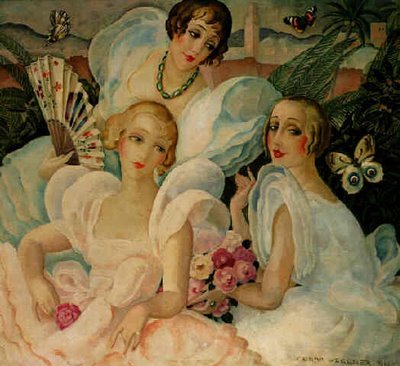
Feminity
Femininity is regarded by Aristasians as primarily a Cosmic quality. Miss Alice Lucy Trent writes in The Feminine Universe:
"Femininity has always been recognised as one of the fundamental Essences or Archetypes of the human world. And not only of the human world; for throughout most of our history - throughout all but the tiniest part of it - it has been recognised that what is true of humanity is also true of the cosmos.
"The sun and moon existed long before the ball of gas and the ball of rock came into being that incarnate them outwardly for us. Numbers were before there were things to be numbered. And femininity existed long before any female creature came into existence.
"For in each of these cases, we are speaking of primal Realities. Principles that cannot not be. Realities that may be manifested in different ways upon different levels of being, but which are not dependent on this or that manifestation for their actuality."
Aristasians do not see femininity as being fundamentally the converse of masculinity. Biologically, the human body is female from conception: only exposure to male hormones can make it male. Similarly, Aristasians would regard femininity as primary and natural, with masculinity being simply a possibility that may or may not come into manifestation under certain specific circumstances.
As has been pointed out, the term "the Eternal Feminine" is well known and strikes a deep resonance in the human heart. No one has postulated an "Eternal Masculine" with the same sort of spiritual depth. Aristasians would explain that this is because masculinity is not eternal.
It will be argued that the term "feminine" makes no sense except in juxtaposition to the term "masculine"; and Aristasians would fully agree. There is no word for "feminine" in Aristasia Pura precisely because there is nothing to contrast it to. For a Pure Aristasian, femininity is simply the nature of things, the mother-heart of the universe. It needs no name; it simply is.
Masculinity, in contrast, can only exist in contradistinction to femininity, because femininity is primal and masculinity is one possible deviation or departure from Primal Reality that may or may not develop depending upon local conditions.
While some peoples are schizomorphic, having two sexes expressing, in one case, the primary feminine nature of being and, in the other, a certain kind of deviation from that nature; other peoples are intemorphic having two sexes that, while manifesting different characteristics, both remain closely bound to the primary nature of being.
Source
#aristaisan#aristasia#encylopaedia aristasiana#intemorphic#schizomorphic#intermorphic sexes#blondes and brunettes
3 notes
·
View notes
Text

Source The year of the goddess : a perpetual calender of festivals, 1990
I've seen elsewhere why the Madrians dated their years the way they did, but I could never find the source of that info again. This particular book says that it is intended to be the number of years after the founding of the temple of Artemis at Ephesus.

I am by no means an expert on Aristiasan/Madrian calendars, and I must admit they make my head spin, but it seems that the later Aristasians and Chelouranyans used a different, perhaps not Tellurian, calendar. I frequently have to reference the 3332 2012/2013 calendar to wrap my head around the dates.
2 notes
·
View notes
Text
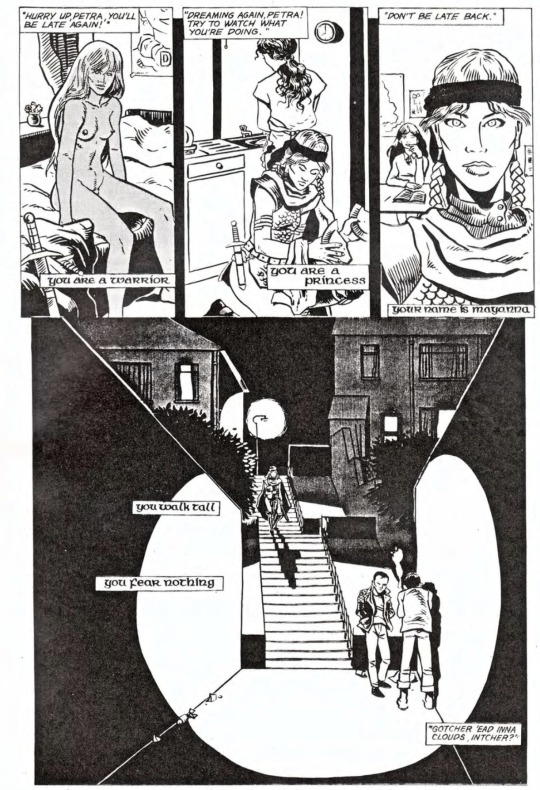
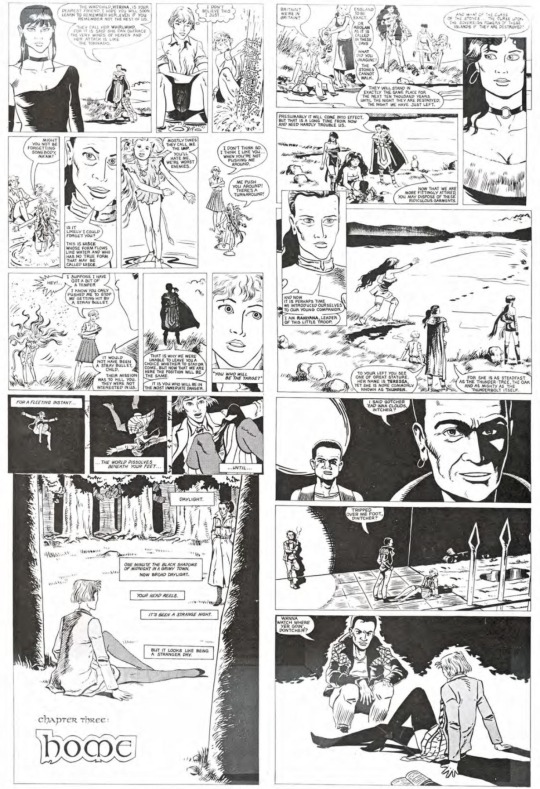
In a May 1986 German computer game magazine, we are lucky enough to find a couple pages from the Silverwolf comic, which didn’t properly come out until 1992.
This game apparently came with a complete comic, but I’m still on the hunt for it. The Silverwolf story was also told in 1983 Artemis zine and appears to be about the matriarchal history of Telluria. The Artemis published story is credited to Laeretta Krenne-Genovene.
I believe this is the same artist who did the other comics associated with the girls from St. Brides.
#Silverwolf#Aristasia#aristaisan#st brides school#light games#aristasian video games#vintage computer games#aristasian literature#Laeretta Krenne-Genovene
2 notes
·
View notes
Text
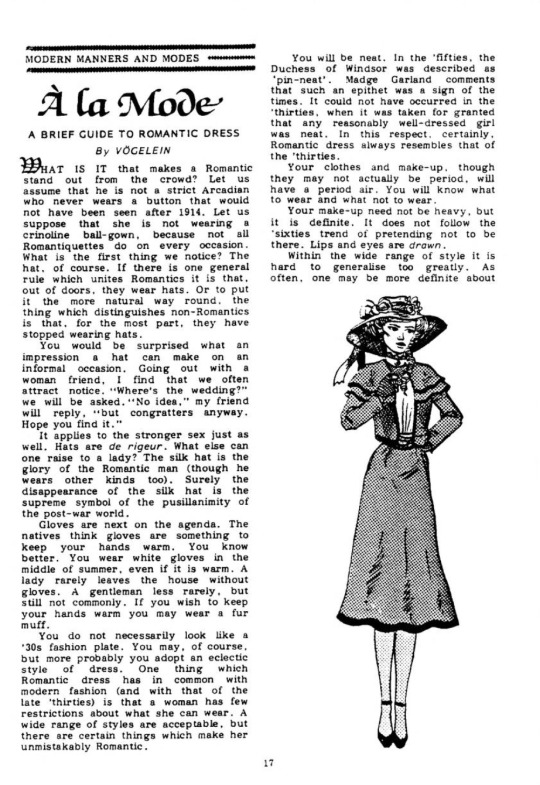
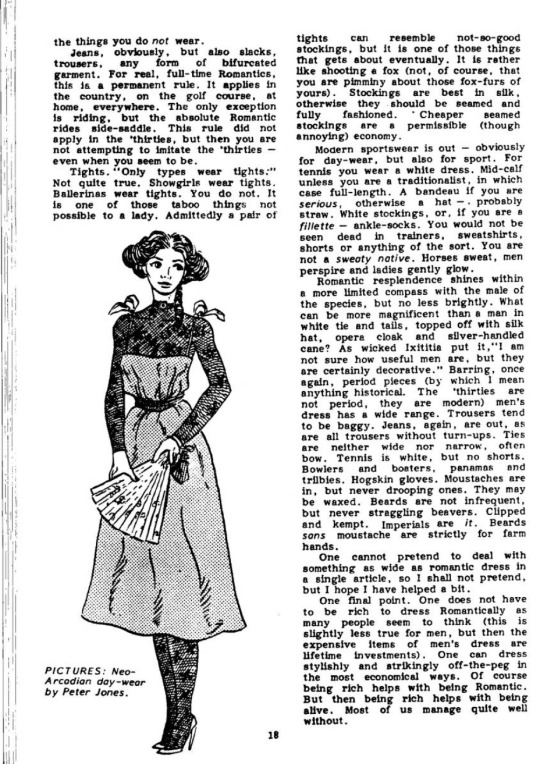
You can see the groundwork being laid for the iconic, fully developed, Aristasia of the 1990s in the old 80s Romantia zines. Romantia being their mixed gender social group that bridged the gap a bit between their 1980s Victorian-esque lifestyle and their mid-90s onward love affair with the 1920s-1950s fashion. In these old zines you can see terms like “Arcadia” “pippsie” “up-to-date” and the iconic “blondes & brunettes” first being used.
Aristasia really seemed to be a merging of the religious side of their Rhennish experiment and the social elitism and aesthetics of the Romantics. It’s interesting to note that both of these initially included em-ee-en.
This zines are available on archive.org under a number of different names, but easily found with the tag “Aristasia”.
5 notes
·
View notes
Text
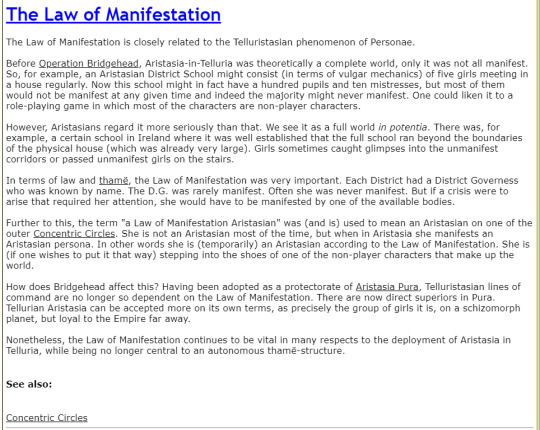
An interesting Encylopaedia entry about "Manifestation" which seems to be a used along the lines of their idea of Life Theatre.
What I wouldn't give for those stories about seeing ghostly girls on their stairs of St. Brides!!
The link to "Concentric Circles" was never archived, but I would assume it has to do with the idea of concentric circles of how involved with one is with Aristasia: Girls who show up from time to time to mingle in the outer circle, and the fully seceded from Tellurian life at the center. However, there was perhaps only ever one girl in that center circle: Miss Sushuri, the Mushroom Princess.
3 notes
·
View notes
Text

Aristasian Wheel of the Year
Aristasians, for the most part, follow the Filianic Calendar. However, I believe that it was only relatively recently in their history when they started to use this calendar on a regular basis.
You can cross reference this with their perpetual Calendar to see what the current year would look like. Just add the days of the week in the order that they match up with the current at the top of each month. For example, 2023's week would start on a Tuesday.
They are 1320 years ahead of us, so 2023 would be year 3343. Their years start on March 21st, with their holiday Eastre.
I have to admit that attempting to think about alternative calendars confuses me, so it's possible my math is wrong!
6 notes
·
View notes
Text
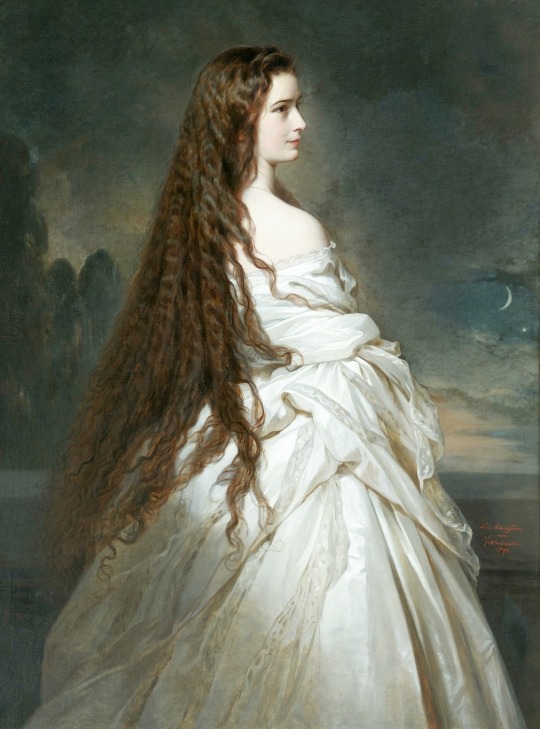
The Word "Maid" In Aristasia
Source
The word "maid" (earlier "may") signifies primarily the power of choice, being cognate with the modal auxiliary verb "may" (as in "this may happen") which expresses possibility or, by extension, permission.
The past form of "may" is "might" which can also mean "power". The two meanings are closely connected, for a thing that may happen, clearly has the power to happen. Thus, to take a different word-group, our words "potential" (possibility) and "potency" (power) are closely derived from the same Latin root.
"Maid" is thus defined as "she who has the power of choice". In late-Telluria, various attempts have been made to define generic "man" in terms of "his" supposed animal origin (the thinking animal, the speaking animal, the tool-making animal etc.) Each definition tries to single out the central characteristic that distinguishes man from other creatures. In Aristasia the definition of "maid" as "she who has the power of choice" is fundamental to Aristasian thought.
The reason for this is that maid is the Axial Being. If we take the symbol of the cross to represent the cosmos, the horizontal bar represents a plain of being, such as our world, while the vertical beam represents the World-Axis which connects this world to other planes of being and ultimately to the Solar Spirit. Maid exists in this particular material world - in other words she is on the horizontal bar - but unlike other creatures of this world, be they animals or elementals, she is on the Axis. Thus she has the power to choose. She may choose to rise above her earthly nature as a saint or a contemplative, or to sink below it as a degraded person. No animal can either rise above¤ or fall below its animal nature.
Thus what defines maid is her Axial nature. He other qualities, such as her intelligence, her power of speech and her ability to fashion tools are all functions, or consequences, of her Axiality. Maid as the Axial being mediates between the Spirit on the one had and the world on the other. It is for this reason that maid is termed "lunar", because, like the moon, she mediates between the light of the Spirit and the darkness of the material world.
Thus the nature of maid is always to some extent "priestly". It is also regal, which is why maid is sometimes termed "the Princess Regent" - she who rules the world in the Name of - and as the surrogate of - Dea.
¤(Some would argue that animals can under certain circumstances transcend their animal nature, but this would always be owing to their association with maid. It is of course true that animals embody Celestial prototypes and symbols, but this does not confer upon them a power of choice. Quite the reverse: unlike maid, their nature compels them to "live up" to their symbolism.)
5 notes
·
View notes
Text
I've managed to save my archived Yahoo Groups into a convenient PDF form. It has it's drawbacks, but it's an easy way to peruse the archived Yahoo Groups.
This particular group is the "MissMartindales" group, it was something of a fan group created in the early 2000s by people who remembered the late night BBC documentary from 1996. It attracted a handful of actual Aristasians, but mostly it was fans of the em-aye-elle-ee persuasion who were intrigued by what they saw that late night on BBC.
However, it's an incredibly interesting piece of Aristasian history. The history of Aristasia is plainly spoken of by Aristasians and people who were there in the Romantia community. There are even attempts at a Romantia revival. And, ultimately, this forum is where the 2010s great divide springs from.
Once Aristasians started to lean heavily into Japan, video games, and Anime, it was the Aristasians leftover in this Yahoo Group who were upset with the change, and vowed to take the name back. They did this by acquiring as much old, 1990s style, Aristasian archived websites and literature as possible, purchasing the lapsed domain names, and putting it all online as the Aristasian Preservation Project.
In the mean time, the Aristasian forums were discussing the possibility of Operation Bridgehead Phase 2. A handful of days after the APP went live, the url for Chelouranya was purchased and Aristasia officially switched over to Chelouranya. All because of this Yahoo Group.

#aristaisan#aristasia#miss martindale#aristasian preservation project#yahoo groups#chelouranya#bridgehead phase 2
2 notes
·
View notes
Text

A huge thank you to the other pettes diving deep into Aristasia lore and excavating their ancient mythologies.
#aristaisan#aristasia#miss martindale#st. bride's school#children of the void#blonde and brunette#blondes and brunettes#age regression
4 notes
·
View notes
Note
Rayati Miss Starry,
I hope that you are well! I very much enjoy your tumblr, and do hope that you keep it up as so much has already been lost. Even if I was always on the periphery of Aristasia, I did enjoy spending time bopping around on my ordie at the Embassy in Virtualia with other pettes or watching kinnies (Olivia!). I feel a trifle guilty since I was one of the late 2000s members to bring in more of the kawaii aesthetic, wearing Lilian uniforms from Maria-sama ga Miteru before even Sushuri-Madonna made the switch.
I think the tip over into Chelouranya was driven by this and even though there were at times hints of Japonisme already there (especially in Arcadia and Trintesse? Is that the other? The one that’s markedly similar to Tellurian 20s. It’s been over a decade, so I don’t remember everything.). The tip into fandom and otherkin nonsense in elektraspace really seemed driven by that, and even though there was some logic to it I believe their (our) youthful ignorance created chaos since there was a profound lack of understanding of the background and humor in Aristasia (the positive parts). Again, I’ve always been at the periphery, but I do have so much theorizing.
I hope that you’re sure to keep backing up your records on the internet archive wayback machine and keep a pdf back up file of your blog (pdfs are very stable).
I’m not Aristasian myself, nor was I ever, but for a while it was good fun dancing at the Embassy and was sad when the land was removed since I’d assumed it was old enough and in an unchanging are of SL that I thought it was staying preserved in time even if it was empty.
À toute à l’heure,
Amitiés
Miss Rosalie
Rayati Miss Rosalie,
Thank you so much for your kind message. I always, genuinely, appreciate any of these firsthand accounts from the girls who mingled with the Aristasians. I think they’re immensely important to archive, as all that remains are tiny amounts of archived forum posts, and even then, they were all in character.
I would love to hear any other memories you might have of your time dancing at the Embassy! As well as your theorizing, if you’re willing to share!
As you may have gathered from my posts or “about” page, I was also never an Aristasian, I never even had the chance to visit their Embassy in Virtualia, as I never could get Second Life to run well. But I watched them from afar with admiration and frustration, and have very appreciative of any insights and stories from those who were there, as well as their filianist sisters.
I’ve been sure to make backups to the Wayback Machine to any websites I still find available, and have been backing up my own works in multiple locations (I’m working on transferring my Tumblr blog to a, slightly more organized, Wordpress blog, since Tumblr doesn’t always play along with the Wayback Machine), as well as uploading whatever PDFs I find to Archive.org. It’s sad that so much has been lost already, but there are definitely other pettes out there trying to keep the memory of Aristasia alive in some way!
Your Humble Editress,
Miss Starry
2 notes
·
View notes
Text

A firsthand account from a woman who lived at the Donegal household from 1983-1983, before it officially became St. Bride's School
6 notes
·
View notes
Text

Source
I believe that this article was from before they moved into the Donegal house that would later become St. Bride's School.
Note that they were only paying The Screamers £5 a week for rent!
3 notes
·
View notes